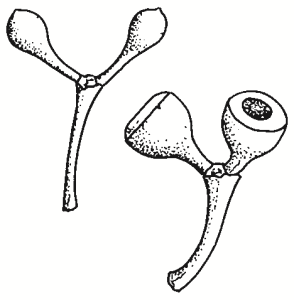Family:
Myrtaceae
Eucalyptus rossii
Scribbly Gum
Other Names: Inland Scribbly Gum, Snappy Gum, Snap Gum, White Gum.
First Nations Name(s):

Name Origin:
rossii — after W.J.C. Ross (1850-1914), teacher at Bathurst Technical College.
Common name refers to ‘scribbles’, a common bark feature.
Regional Subspecies:
Similar Species:
Sometimes confused with Brittle Gum (E. mannifera), but distinguished by its scribbly non- powdery bark, leaves and buds. One of five species known as Scribbly Gum due to insects feeding in the bark, although other four species not within region. They are: E. haemastoma, E. racemosa, E. sclerophylla and E. signata.
Occurrence:
Regional:
Noted in the areas: Carabost, Murraguldrie, Yaven Creek, Lunts Sugarloaf and Four Mile.
Australia:
NSW.
Habitat:
Dry sclerophyll woodland. Poor shallow stony soils on rises, and low ridges in undulating country.
Habit:
Tree to 20 m high with smooth white or yellow bark with scribbles, shedding in short ribbons. Dull grey-green leaves. Diameter at breast height up to 1 m.
Site Preference:
Well-drained soil. Tolerates frost.
Characteristics:
Scribbles in bark are left by insect larvae which burrow beneath bark.
Flowering:
Dec-Feb.
Propagation:
From seed (± 161 viable seeds per gram).
VALUES:
Shade & Shelter:
Useful medium-level cover in windbreaks.
Wildlife:
Nectar-rich flowers are a food source for various native birds.
Fuel:
Burns well.
Timber:
Brittle. Not durable or commercial.
Ornamental:
Attractive specimen for landscaping due to white trunk and spreading branches.
